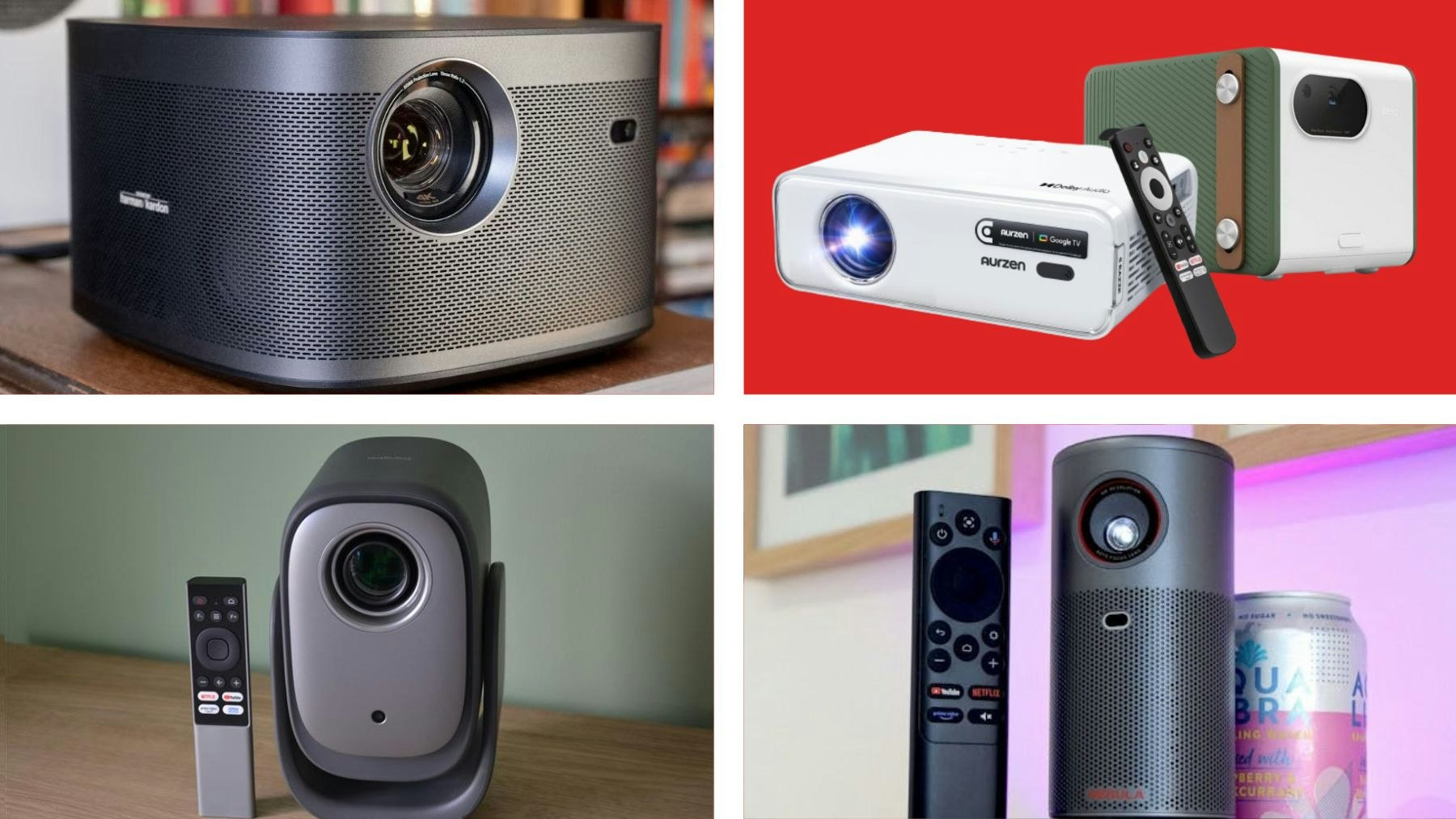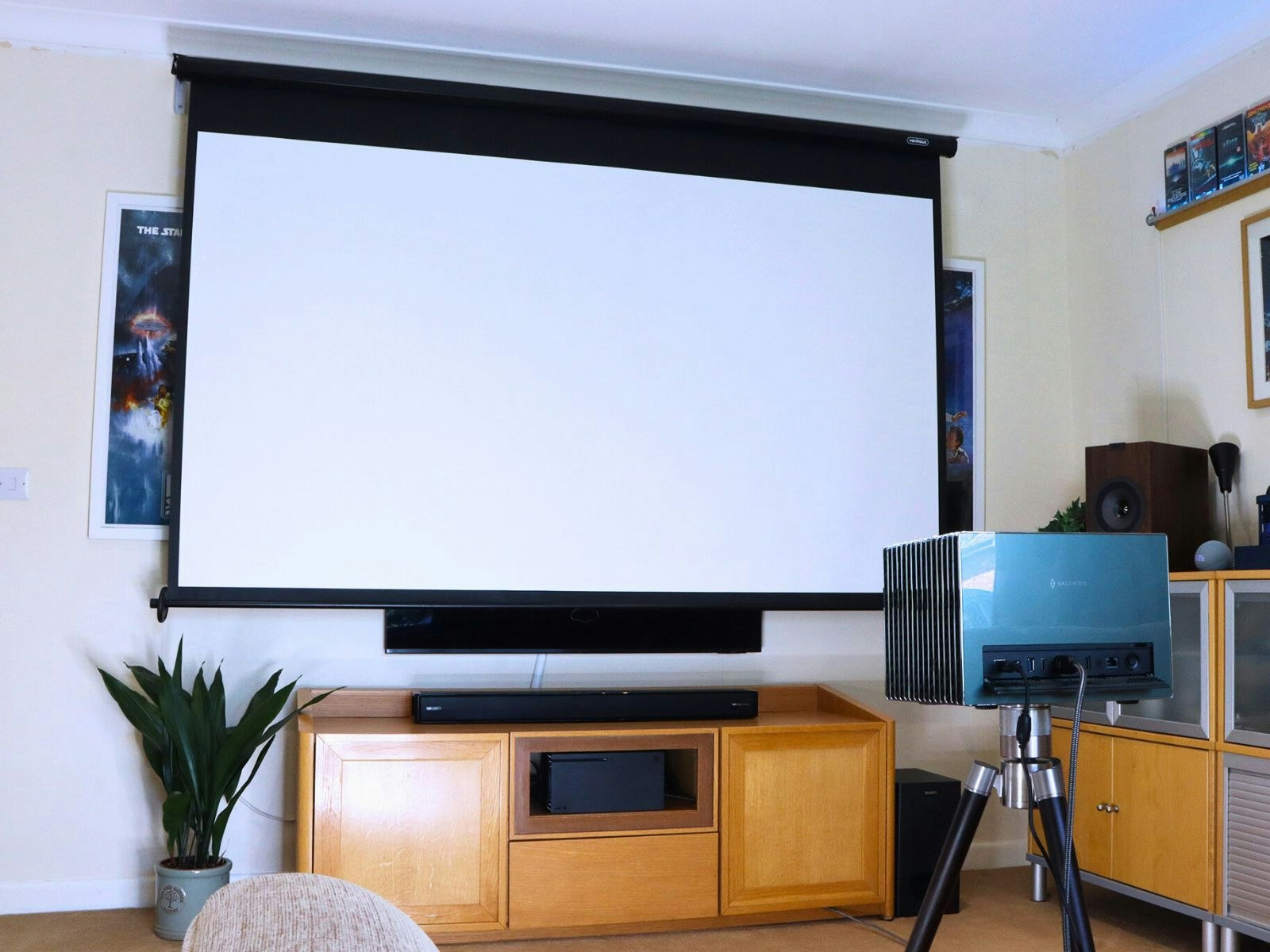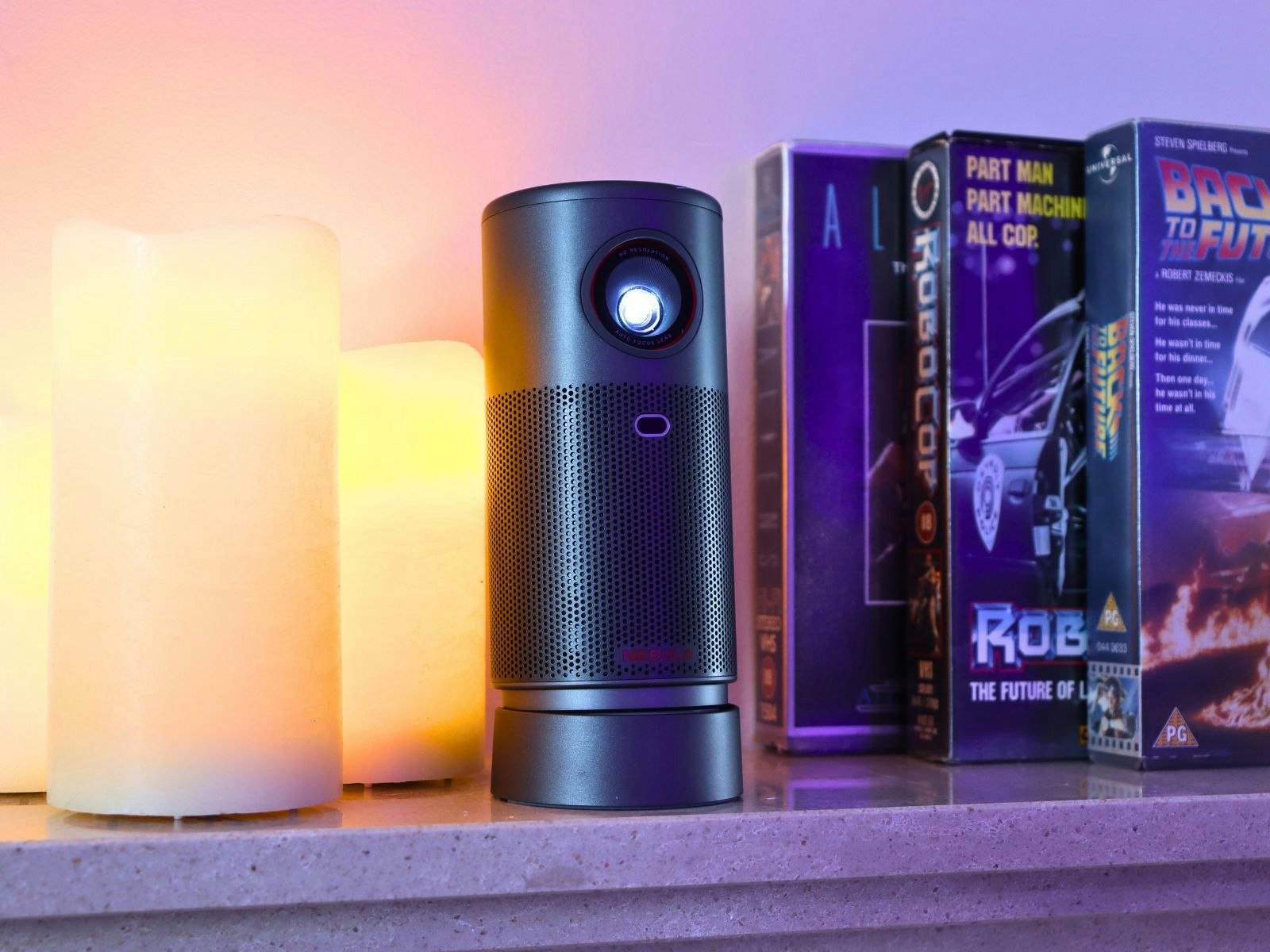The Best Budget Projectors: Bring The Big Screen To Your Home Cinema For Less
Making the leap to a huge screen for your movies is now cheaper than ever.

Once an extravagance seen in state-of-the-art home cinemas, any projector bright enough to actually watch a movie on used to cost well into the thousands. Cut to today, and increasingly powerful tech is making its way into some of the best budget projectors on the market. Suddenly, that 65-inch TV doesn't look quite so impressive...
So what do we mean by 'budget projector'? Most of the models we found for this article are cheaper than many televisions. And that increase in screen size for hundreds rather than thousands of pounds can only mean one thing: your movie nights are going to look spectacular. A white wall or an affordable screen, like the VonHaus 100-inch projector screen we tested in our Valerion VisionMaster Pro 2 review, is all you need to upgrade your experience. Shone onto it, the motorbike-meets-cliff moment in Mission: Impossible – Dead Reckoning gave us flashbacks of sitting at the local cinema.
But surely a budget projector is a dim, low-resolution experience – like it was when you borrowed the office projector for that Lord Of The Rings watchathon a few years ago? Thankfully not. In fact, we find that the only real differences between budget projectors and their £1000-plus counterparts are brightness levels, resolution and picture processing features. Even then, some of those features make it into many of our affordable options – such as budget 4K smart projectors. You won't be getting super-bright lasers, but you will have a picture that's a lot larger than your current TV, and one that can be seen in the daytime without the need for blackout curtains.
Some of our picks are compact and portable with their own speakers built-in, making them a really fun and practical projector choice for parties, trips and even evening garden screenings. So, let's prove that projection is the affordable big TV alternative by shining a light on some of the best budget projectors available right now.
How We Chose The Best Budget Projectors
We've selected the best budget projectors based on reliable and trusted brands, average user reviews, price, and suitability for each use case. We look carefully at the technical specifications of all products before recommending them to ensure that they will meet your needs without the need for costly additions to work as intended. With all of our selections for the best budget projectors, we've looked for a balance of price with image quality and resolution, brightness, maximum projection size, sound format support, smart features, build quality and overall design. We also look for good connectivity with a range of devices and extra control options, such as via companion apps. All of our writers may also choose products based on hands-on experience where we own or have reviewed them ourselves. Retailers are selected based on price, availability and reputation as reliable and trusted sellers. Find out more about how we recommend products.
All prices are correct at the time of writing. Prices, stock and deals are subject to change without notice.
Best Budget Projectors in 2025
Expert's choice: The Best Budget Projector
We've chosen an entry-level projector as our best overall option – the Dangbei N2 Mini Smart Projector. While it would have been very easy to have awarded the Anker Nebula Cosmos Laser 4K Projector the top spot based on tech specs alone, it's at the highest end of the budget category – and beyond what some might consider an affordable first step into the world of projected entertainment. However, the Nebula is our favourite on this list for spec and features, with the Dangbei being a solid performer at the other end of the price range.
What To Look For In A Budget Projector
Whatever model you settle on, it should offer something that even the best TV of a similar price doesn't. If you're looking for something super-small and under £100, even the best budget pico projector (AKA: micro-sized projector) is not going to outdo your faithful TV. For most of us, the decision will be based on sheer screen size, but there are some other things to consider when it comes to making the right choice.
Brightness Is (Almost) Everything
Firstly, it's worth taking the time to understand the way that various projector brands state their products' brightness levels. We'll expand on this in our projector tech glossary below. But, as a quick overview, you might see brightness measured in lumens – most commonly ANSI lumens or ISO-Lumens. However, there's no fast and accurate way to convert one to the other, as each standard has different measures and test conditions. So, although ISO lumens are generally around 0.8 times as bright as the equivalent number of ANSI lumens, this isn't scientific. Remember, a projector may state its brightness in ISO lumens – but that doesn't always make it less bright than another measured in ANSI lumens – it's just a different measurement standard.
When buying, our advice is to keep one eye on the stated brightness level of your top choice of projector. Then see how much a brighter one (measured in the same units) would cost. For instance, if your chosen model is rated as 350 ANSI-Lumens, try looking for a brighter one. If it's still within budget and has some of the other features you like, always go for the brightest budget projector you can.
What Brightness Do I Need?
Nebula has an excellent guide to ANSI versus ISO lumens that includes recommendations on the optimal brightness you should be looking for with a projector. Here's a general guide depending on your viewing conditions:
As with all budget projectors, brightness and contrast are heavily impacted by the amount of ambient light in your room. Even though some projectors are easily bright enough to be seen in the daytime in a room without harsh ambient light, we always recommend as little ambient light as possible.
Another thing to remember is that the apparent brightness level reduces the farther the projector is from the screen, so if you're planning on using a projector with a low-end brightness rating for a very large image, you may want to up the number of ANSI/ISO lumens.
Choose Your Projector Technology
The core projector technology you choose directly impacts brightness, colour and contrast. The premium choice is still laser-based projectors, as they can offer brighter and more vivid images with more detail. They're also more energy-efficient than a traditional LCD projector that uses a lamp as a light source. That said, lamp-based projectors can be just as bright as laser (and cheaper), so don't discount one if the price and features are right for you.
You'll also find projectors that boast DLP (Digital Light Processing). This method of reflecting the image through the lens is used with both laser and LCD-based projectors and often results in more detail and less motion-blur.
Use A Projector Screen
Although relying on a large open wall in your home might seem to be the easy option, it's actually one of the least practical and most problematic. Firstly, you'll need to paint it white to get the best image and contrast from your budget projector. Yes, you'll find plenty of projectors with settings that compensate for an off-white or colour-tinted light wall, but they do so by substantially altering the colour profile of what you're watching. If you're all about enjoying movies the way the director intended, complete with expert colour-grading, an off-white wall is not the way to go.
Secondly, you'll need to make sure that the wall is continually blemish-free. This means no picture hooks or nails – so, making use of your wall while not watching is also a no-go. Lastly, many budget projectors have built-in screen detection that adjusts the projected image to perfectly fit a 16:9 screen ratio. As most projector screens have a black border that denotes the white 16:9 ratio, the projector will be able to detect that border and do a lot of the hard work for you with keystoning and other refinements.

Match Screen Size With Your Projector's Throw
If you have a screen size in mind, always check the projector specifications to make sure its lens can handle the size you need. Don't assume that you'll get an image as large as you want by simply increasing the space between it and the screen. Picture size is all about the power of the laser or lamp, plus the optics inside that will throw the image onto the screen. Most projectors will state their maximum image sizes in inches (measured diagonally, corner-to-corner), so double-check before you buy.
Long Throw Versus Short Throw Projectors
Although short-throw projectors will be a rarity in the budget category, they are worth hunting down if your room is particularly short on space. So, what are short and long throw projectors?
Long Throw Projectors: As the name suggests, these projectors need to be placed some distance from the screen (or wall) to project a larger image. Generally, long throw projectors need to be placed over two metres away or more to achieve a large enough image.
Short Throw Projectors: This type of projector is designed to sit extremely close to the screen or wall, as close as a few centimetres. Its optics are designed to project the image almost perpendicular to itself, without any loss in brightness at the far edge of the image. Ultra Short Throw projectors do the same but at an incredibly short distance from the screen. Because of this, they're almost always laser projectors, as the extra brightness is needed to throw the image upward from such a short distance.
They're great space-savers and make for a neater setup over the long cable run and mid-room placement of the long throw version. However, bear in mind that the short throw variety requires a perfectly flat surface. The short throw distance means that it'll show every ripple, bump and distortion of a regular roller projector screen, tensioned screen, or even a wall. You'll need a fixed projector screen – which is essentially a tensioned white canvas that you'll need to permanently wall-mount or store somewhere.
Go for 4K if your budget allows
Although projector tech has become more affordable, the vast majority of the budget projector category has Full HD (1080p) resolution or lower. This is especially true with many of the best mini projectors. In terms of modern viewing habits, and certainly where any serious film fan is concerned, this is decidedly last generation. However, if you haven't fully embraced 4K entertainment yet and have a large collection of standard Blu-ray discs rather than the 4K UHD variety, you might find that a Full-HD budget projector has everything you're likely to need.
That said, with so much content streaming in 4K (not to mention high-tech extras that come with it, like HDR for a billion extra colours) it's definitely the optimal choice. Movies and shows on 4K Blu-ray disc are much more prevalent now too, so you're in for a cinema-like experience. You may have been content with borrowing the office's budget projector for PowerPoint presentations a few years ago, but that's not going to do justice to today's high-resolution media.
Plan For Placement And Connectivity
One of the most overlooked and troublesome aspects when choosing a projector is placement. Yes, you can ceiling-mount a projector to declutter your floor space, but you'll need to route power HDMI cables through the ceiling too. Unless you're planning on projecting the majority of your entertainment, we recommend a floor-standing projector, preferably on its own small table so that the whole thing can be easily packed away or moved into a safe corner when not in use.
Need A Gaming Projector? Look At Refresh Rate And Low Latency
These two features go hand-in-hand for console gamers looking to project their adventures. Search for a projector that supports low-latency features, possibly via a dedicated Game Mode. This will mean a fast reaction time between what you do with your controller and what happens on screen. The refresh rate for gaming is often 120Hz at the high-end, so if you're into smooth, judder-free 4K gaming, look for that or 60hz at a minimum. VRR (Variable Refresh Rate) isn't found on many low-budget projectors, but if you find one you're in for an even smoother gaming experience thanks to the projector matching the changing framerate of your console.
HDMI And Power
If your smart projector is going to be used with more than just onboard apps, you'll need something like the five-meter Southlight HDMI 2.1 Cable. Thankfully, these long cables are affordable, and they can be up to 10 metres or more, depending on your needs. Projector power supply is also a consideration, especially with a projector that must sit in the middle of the room while in use.
None of the models in our lineup above comes without HDMI. However, if you find yourself tempted by a better deal, you should make sure that it has HDMI and not just analogue AV inputs – these are red and black (or white) phono plugs for audio, and yellow for video. Likewise, many cheaper and older projectors are designed for office use and may only include computer and laptop-friendly inputs, like VGA and DVI. Not only are these lower resolutions than 4K or even full HD, but you won't find these on most modern consoles or media players either.
Plan For Sound
While some budget projectors can process and output spatial audio formats like Dolby Atmos or DTS
Whether you're going to use a good budget soundbar or a more expensive system with your budget projector, it's important to check that your projector has a dedicated digital audio output. This is often an HDMI port with ARC (Audio Return Channel) support; preferably the more advanced eARC version that supports high-definition surround formats like DTS-HD and Dolby TrueHD. You can read more about HDMI ARC/eARC in our guide to surround sound jargon below.

Budget Projector terminology
The best budget home projector will differ from standard office projectors in fairly major ways when it comes to performance and connectivity. But this is not always clear from the model name alone, so it pays to know your stuff before you buy. Here are some of the most common projector terms you'll come across.
Lumens
A lumen is a unit of measurement used to gauge the amount of light emitted from a range of technologies. An ANSI lumen describes light as measured from projectors, and so is measured differently to ensure accuracy. Although you'll find some projectors listed with the alternative ISO lumen rating, it's not as widely adopted in the projector market. As a very rough rule of thumb, one ANSI lumen is equivalent to around 0.8 ISO lumens.
Contrast Ratio
The contrast ratio of a projector is the measurement between the brightest part of the image and the darkest. So, a ratio of 2000:1 would be used to describe a projector that was capable of projecting a light 2000 times brighter than the darkest part of the image. The higher the contrast ratio the better the apparent black levels will seem thanks to the brightest areas being extra bright.
Throw Range And Throw Ratio
The range is the distance between the projector's lens and the screen, and the throw ratio is the relationship between that distance and the size of the projected image. When buying a projector, both of these are only really relevant when planning the placement in your room. If you want a 100-inch image from a projector with a long throw range and a low throw ratio you'll need to plan to have it quite some distance from your screen.
Resolution
As with TVs, there are three main resolutions commonly found in projectors: Half HD (1280 x 720 – also known as 720p), Full HD (1920 x 1080 pixels / 1080p) and 4K – also known as UHD (Ultra High Definition). The latter has 3840 x 2160 pixels (2160p). The higher the resolution, the more pixels make up the image, resulting in higher detail and clarity.
HDMI
HDMI is a digital interface that carries both audio and video signals through a single cable or port. The main advantage here is convenience – you don’t need individual cables for sound and vision, making your setup much tidier and simpler. Plus, because it’s digital, HDMI delivers far better quality than older analogue connections. The latest HDMI 2.1 standard supports much higher data bandwidth, allowing for even better performance with 4K (and even 8K) content and high-res spatial audio.
ARC / eARC
Getting sound and vision from your Blu-ray player or gaming console to a projector used to be a tangle of wires. Now, HDMI cables with ARC and eARC make a huge difference. ARC, or Audio Return Channel, is a feature of certain HDMI ports that lets audio flow in both directions – sending sound back through the same cable it came in on. This feature streamlines your wiring and simplifies system setups.
Imagine you have a smart projector connected to a soundbar using its HDMI ARC port. When you watch a movie using an app on the projector, audio is sent to the soundbar. If you have an Xbox or Blu-ray player connected to the soundbar, the video can travel back to the projector along the same route. So, no need for separate video-in and audio-out wiring.
eARC, or Enhanced Audio Return Channel, builds on this by offering even more bandwidth, so it supports lossless surround sound formats like DTS-HD and Dolby TrueHD. This includes advanced spatial audio such as Dolby Atmos, providing top-tier audio quality and immersion.
Latest Updates
This review was first published in August 2025. Any future relevant updates and additions will be added here.
Chris Duffill is a senior tech reviewer, writing for Empire, What's The Best, Yours, Closer, Heat and other brands. He specialises in home entertainment and audiovisual tech, including TVs, projectors, speakers, amplifiers, turntables and more.
What's Your Reaction?











